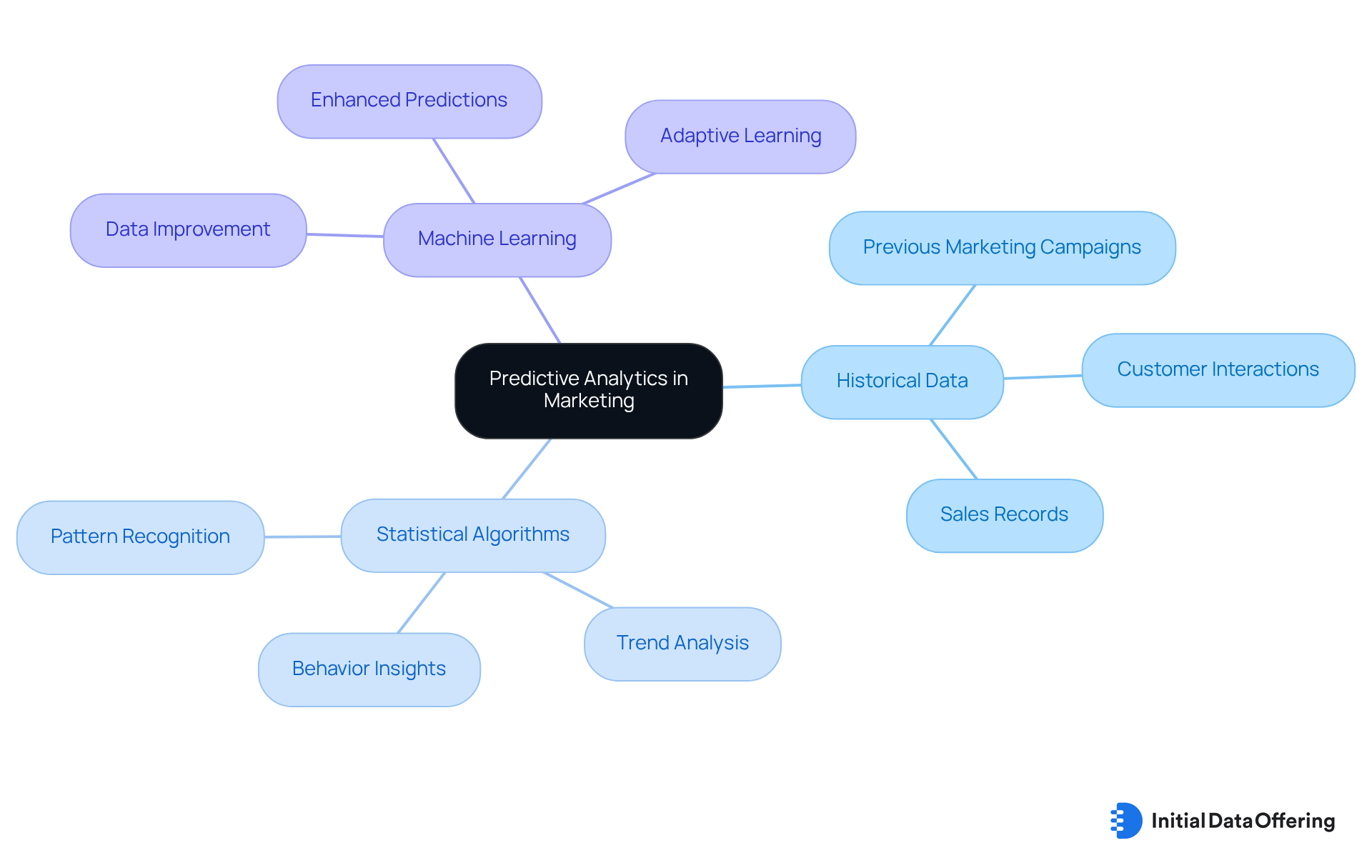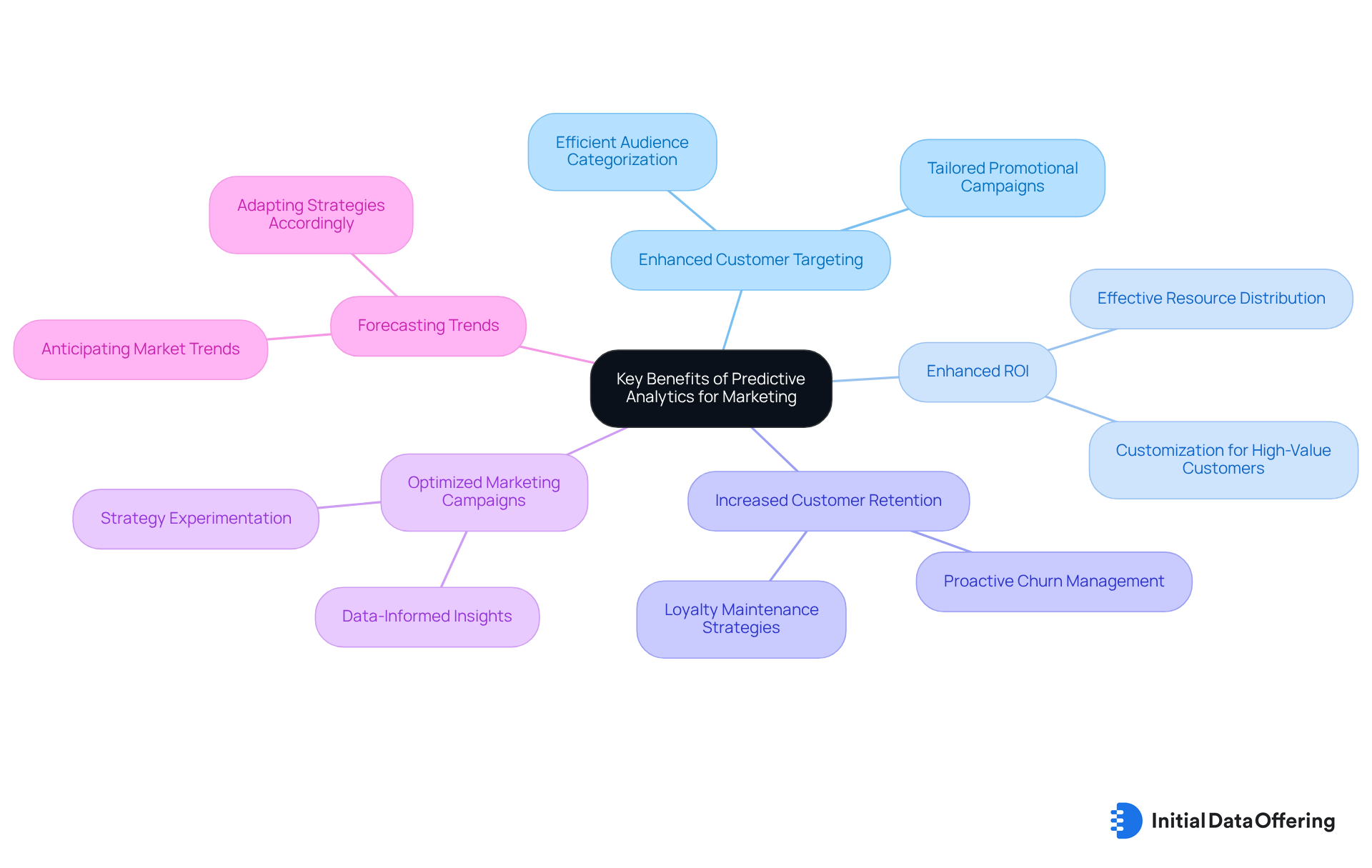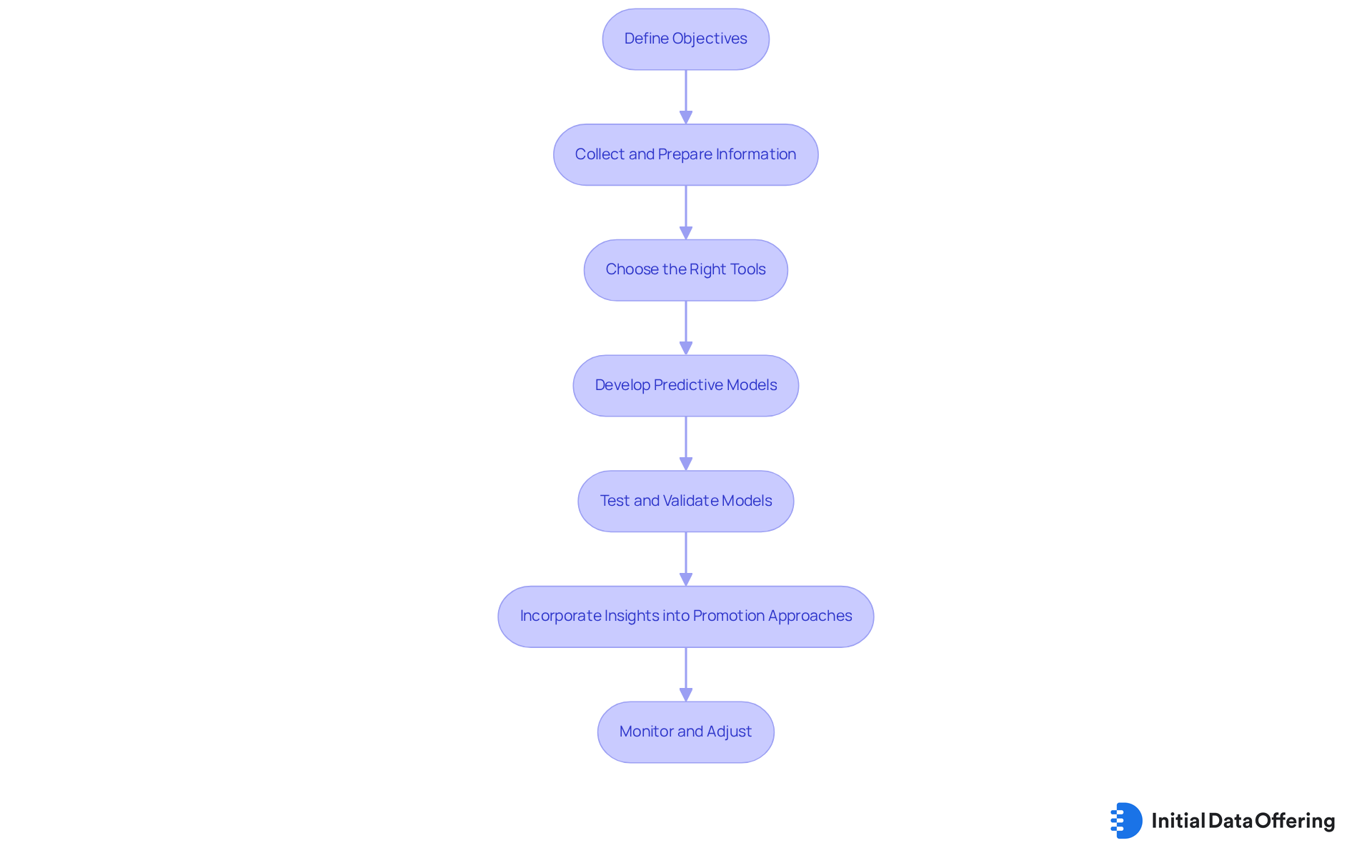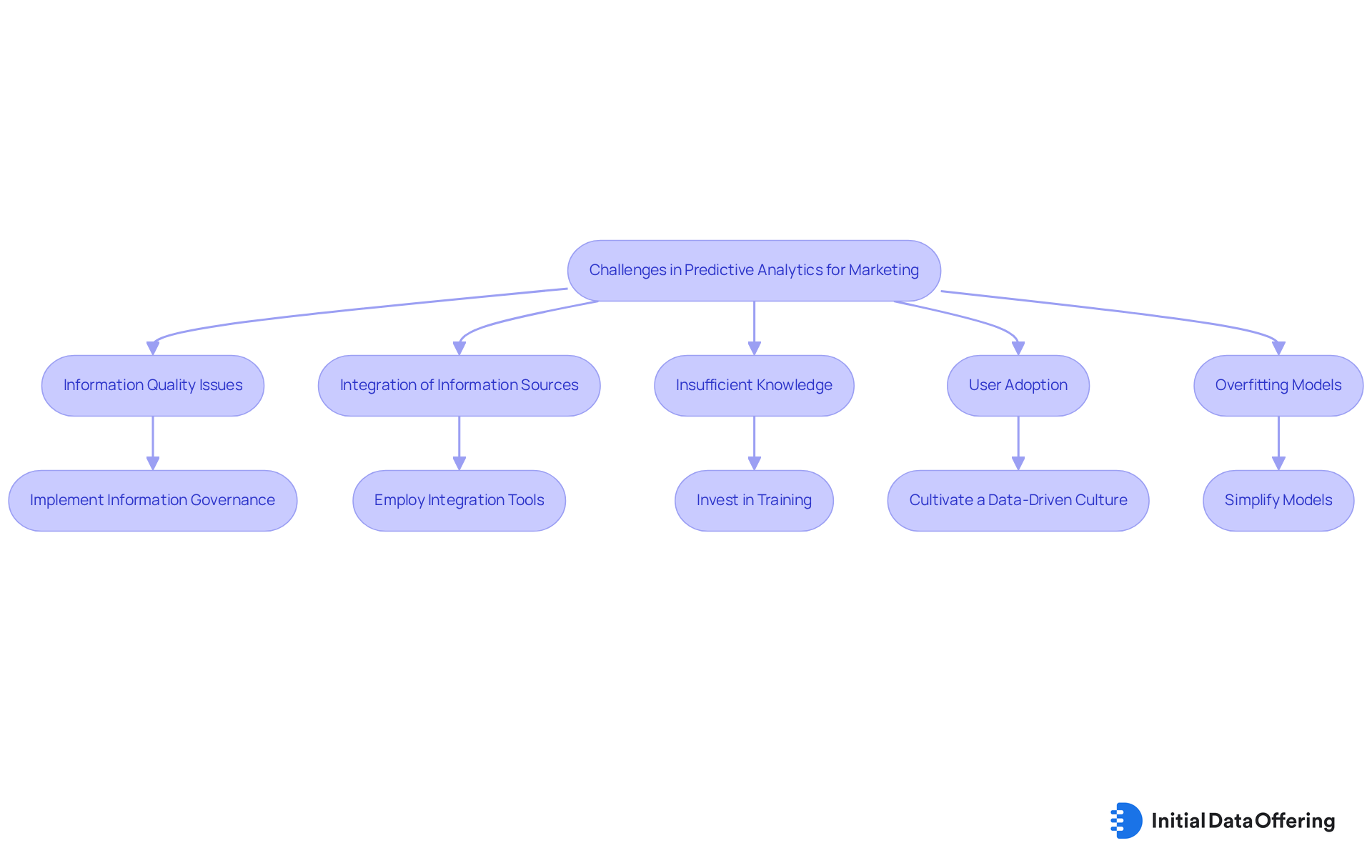Master Marketing Predictive Analytics for Effective Strategies

Master Marketing Predictive Analytics for Effective Strategies
Overview
The article highlights the significance of mastering marketing predictive analytics, demonstrating how it can lead to more effective strategies by leveraging historical data and advanced algorithms to forecast customer behavior. The key components and benefits of predictive analytics are explored, including enhanced customer targeting and optimized marketing campaigns. By detailing implementation steps and addressing potential challenges, the article underscores its critical role in shaping data-driven marketing efforts.
What makes predictive analytics essential for marketers? It allows for precise customer targeting, which can significantly improve campaign effectiveness. The advantages of utilizing such analytics include not only better understanding of customer behavior but also the ability to adapt marketing strategies based on predictive insights. Ultimately, this leads to more successful marketing outcomes and a stronger return on investment.
As marketers look to implement predictive analytics, they should consider the necessary steps and potential hurdles. This approach ensures that they are well-prepared to harness the full power of data-driven insights, fostering a more strategic approach to marketing that resonates with today’s consumers. By embracing predictive analytics, businesses can position themselves at the forefront of their industries, driving innovation and growth.
Introduction
In an age where data reigns supreme, the ability to predict customer behavior has become a game-changer for marketers. Predictive analytics utilizes historical data and advanced algorithms, unveiling insights that can significantly shape effective marketing strategies. The challenge, however, lies not only in understanding these tools but also in implementing them effectively to maximize their potential.
How can marketers navigate the complexities of predictive analytics to transform their promotional efforts and drive engagement? By addressing these questions, marketers can unlock the full power of predictive analytics, leading to more informed decisions and enhanced customer interactions.
Define Predictive Analytics in Marketing
Predictive analytics in promotion encompasses the utilization of historical data, statistical algorithms, and machine learning techniques to ascertain the likelihood of future outcomes based on past behaviors. This approach empowers marketers to forecast customer behaviors, refine promotional strategies, and enhance decision-making processes. For instance, by analyzing past purchasing trends, companies can predict which items a customer may select next, thereby facilitating targeted promotional efforts that resonate with individual preferences.
Key Components of Predictive Analytics:
- Historical Data: This includes information gathered from previous marketing campaigns, customer interactions, and sales records, providing a foundation for analysis.
- Statistical Algorithms: These mathematical models scrutinize the data to uncover patterns and trends, offering insights into customer behavior.
- Machine Learning: As a subset of artificial intelligence, machine learning improves predictions as more data becomes available, allowing for increasingly accurate insights.
By leveraging these components, marketers can formulate more effective strategies that align with consumer behavior and market trends. How might these insights transform your promotional efforts? By integrating marketing predictive analytics, you can create tailored initiatives that not only meet customer expectations but also drive engagement and loyalty.

Identify Key Benefits of Predictive Analytics for Marketing
The implementation of marketing predictive analytics offers several key benefits that can significantly enhance business outcomes.
-
Enhanced Customer Targeting: By examining customer information, companies can categorize their audience more efficiently. This enables tailored promotional campaigns that connect with specific groups, ensuring that marketing efforts resonate with the right individuals.
-
Enhanced ROI: Predictive insights assist marketers in distributing resources more effectively, concentrating on strategies that produce the greatest returns. For instance, by recognizing high-value customers, businesses can customize their promotional efforts to enhance engagement and conversion rates, ultimately leading to a better return on investment.
-
Increased Customer Retention: By predicting customer behavior, companies can proactively address potential churn. Implementing retention strategies before customers disengage helps maintain loyalty and reduces turnover, which is crucial for long-term success.
-
Optimized Marketing Campaigns: Predictive analysis allows marketers to experiment with different strategies and anticipate their results. This results in more effective campaigns that are continually improved based on data-informed insights, ensuring that marketing predictive analytics align marketing efforts with customer needs.
-
Forecasting Trends: Businesses can anticipate market trends and consumer preferences, allowing them to stay ahead of the competition. By adapting their strategies accordingly, companies can position themselves effectively in a rapidly changing environment.
These advantages collectively empower marketers to make informed choices that improve overall promotional effectiveness. How can your organization leverage predictive analytics to enhance your marketing strategies?

Implement Predictive Analytics Techniques in Marketing Strategies
To effectively implement predictive analytics in marketing strategies, it is essential to follow a series of structured steps that ensure clarity and focus on objectives.
-
Define Objectives: Start by clearly outlining what you aim to achieve with predictive data analysis. Are you looking to increase sales, improve customer retention, or enhance campaign effectiveness? Establishing specific goals will guide your efforts.
-
Collect and Prepare Information: Gather historical data from various sources, including CRM systems, social media, and website metrics. It is crucial to ensure that the data is clean and organized, as this will facilitate a smoother analysis process.
-
Choose the Right Tools: Select forecasting tools that align with your objectives. Popular options include Google Analytics, IBM Watson, and Salesforce Einstein. Each tool offers unique features that can enhance your predictive capabilities.
-
Develop Predictive Models: Utilize statistical algorithms and machine learning techniques to create models that can forecast future customer behavior. Techniques such as regression analysis, decision trees, and clustering are effective in building robust predictive frameworks.
-
Test and Validate Models: Before full implementation, it is wise to test your forecasting models on a smaller scale. This allows you to validate their accuracy and make necessary adjustments based on performance metrics.
-
Incorporate Insights into Promotion Approaches: Use the insights gained from your forecasting analysis to inform your promotional strategies. Tailor campaigns based on predicted customer behavior and preferences to maximize engagement.
-
Monitor and Adjust: Finally, continuously observe the performance of your forecasting models and marketing campaigns. Regular adjustments are necessary to optimize results and ensure that your strategies remain effective.
By adhering to these steps, marketers can effectively utilize forecasting techniques to refine their strategies and achieve better results. Consider how these approaches can be applied to your own marketing efforts for improved outcomes.

Overcome Challenges in Using Predictive Analytics for Marketing
While marketing predictive analytics presents numerous advantages, marketers often encounter several challenges during implementation. Understanding these obstacles is crucial for leveraging predictive analytics effectively. Here are common challenges and strategies to overcome them:
-
Information Quality Issues: Substandard information quality can lead to inaccurate predictions. Regularly cleaning and validating information is essential to maintain its integrity.
- Solution: Implementing information governance practices and utilizing validation tools can help catch errors early, ensuring the reliability of the data.
-
Integration of Information Sources: Merging information from diverse origins can be complex and labor-intensive. A streamlined integration process is vital for efficiency.
- Solution: Employing integration tools can simplify the process and ensure a seamless flow of information across platforms, enhancing overall data coherence.
-
Insufficient Knowledge: Many organizations may lack the necessary skills to analyze and interpret forecasting data effectively.
- Solution: Investing in training for the marketing team or hiring data analysts with expertise in forecasting models can bridge this knowledge gap, fostering a more informed approach to predictive analytics.
-
User Adoption: Resistance to change can hinder the successful implementation of forecasting methods. Cultivating a supportive environment is key.
- Solution: Fostering a data-driven culture by demonstrating the value of predictive analytics through successful case studies and encouraging team involvement can enhance user adoption and engagement.
-
Overfitting Models: Creating overly complex models can lead to overfitting, where the model performs well on training data but poorly on new instances.
- Solution: Simplifying models and employing techniques such as cross-validation can ensure they generalize well to unseen data, improving their effectiveness.
By proactively addressing these challenges, marketers can significantly enhance their predictive analytics capabilities, ultimately driving more effective marketing strategies. How can your organization implement these solutions to overcome similar obstacles?

Conclusion
Incorporating predictive analytics into marketing strategies is no longer a luxury but a necessity for businesses aiming to thrive in a competitive landscape. By harnessing historical data and advanced statistical techniques, marketers can anticipate customer behaviors and tailor their approaches accordingly. This ensures that promotional efforts are both relevant and impactful.
The article highlights several key components and benefits of predictive analytics. These include:
- Enhanced customer targeting
- Improved ROI
- Optimized marketing campaigns
By defining clear objectives, collecting quality data, and utilizing appropriate tools, marketers can develop robust predictive models that inform their strategies. Addressing common challenges, such as data quality and user adoption, is crucial for successful implementation.
Ultimately, the integration of predictive analytics represents a transformative opportunity for marketers. By embracing these techniques and overcoming potential obstacles, organizations can enhance their marketing effectiveness while fostering deeper connections with their customers. The future of marketing lies in data-driven insights. Leveraging predictive analytics can pave the way for innovative strategies that resonate with consumers and drive sustainable growth.
Frequently Asked Questions
What is predictive analytics in marketing?
Predictive analytics in marketing involves using historical data, statistical algorithms, and machine learning techniques to predict future outcomes based on past behaviors, allowing marketers to forecast customer behaviors and refine promotional strategies.
What are the key components of predictive analytics?
The key components of predictive analytics include historical data, statistical algorithms, and machine learning.
How does historical data contribute to predictive analytics?
Historical data encompasses information from previous marketing campaigns, customer interactions, and sales records, providing a foundation for analysis to understand customer behavior.
What role do statistical algorithms play in predictive analytics?
Statistical algorithms are mathematical models that analyze data to identify patterns and trends, offering insights into customer behavior.
How does machine learning enhance predictive analytics?
Machine learning, as a subset of artificial intelligence, improves predictions over time as more data becomes available, leading to increasingly accurate insights.
How can predictive analytics transform promotional efforts?
By integrating predictive analytics, marketers can create tailored initiatives that align with consumer behavior and market trends, ultimately driving engagement and loyalty.